Advertisements
Advertisements
प्रश्न
Accuracy of potentiometer can be easily increased by ______.
पर्याय
Increasing resistance of wire
Decreasing resistance of wire
Increasing the length of wire
Decreasing the length of wire
उत्तर
Accuracy of potentiometer can be easily increased by Increasing the length of wire.
Explanation:
APPEARS IN
संबंधित प्रश्न
State the principle of working of a potentiometer.
On what factors does the potential gradient of the wire depend?
State the advantages of potentiometer over voltmeter.
State the underlying principle of a potentiometer ?
Figure shows a long potentiometer wire AB having a constant potential gradient. The null points for the two primary cells of emfs ε1 and ε2 connected in the manner shown are obtained at a distance of l1 = 120 cm and l2 = 300 cm from the end A. Determine (i) ε1/ε2 and (ii) position of null point for the cell ε1 only.

In the figure a long uniform potentiometer wire AB is having a constant potential gradient along its length. The null points for the two primary cells of emfs ε1 and ε2 connected in the manner shown are obtained at a distance of 120 cm and 300 cm from the end A. Find (i) ε1/ ε2 and (ii) position of null point for the cell ε1.
How is the sensitivity of a potentiometer increased?
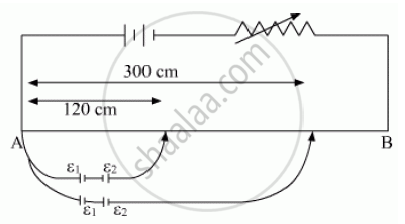
Write the principle of working of a potentiometer. Describe briefly, with the help of a circuit diagram, how a potentiometer is used to determine the internal resistance of a given cell.
When a resistor of 5Ω is connected across the cell, its terminal potential difference is balanced by 150 cm of potentiometer wire and when a resistance of 10 Ω is connected across the cell, the terminal potential difference is balanced by 175 cm same potentiometer wire. Find the balancing length when the cell is in open circuit and the internal resistance of the cell.
The net resistance of a voltmeter should be large to ensure that ______________ .
The potentiometer wire AB shown in the figure is 40 cm long. Where should the free end of the galvanometer be connected on AB, so that the galvanometer may show zero deflection?

When the balance point is obtained in the potentiometer, a current is drawn from ______.
Define potential gradient of the potentiometer wire.
What will be the effect on the position of zero deflection if only the current flowing through the potentiometer wire is increased?
Describe how a potentiometer is used to compare the EMFs of two cells by connecting the cells individually.
Describe with the help of a neat circuit diagram how you will determine the internal resistance of a cell by using a potentiometer. Derive the necessary formula.
A potentiometer wire has a length of 1.5 m and a resistance of 10 Ω. It is connected in series with the cell of emf 4 Volt and internal resistance 5 Ω. Calculate the potential drop per centimeter of the wire.
Find the equivalent resistance between the terminals of A and B in the network shown in the figure below given that the resistance of each resistor is 10 ohm.
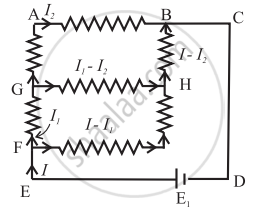
Why is a potentiometer preferred over a voltmeter for measuring emf?
When two cells of emf's E1 and E2 are connected in series so as to assist each other, their balancing length on a potentiometer wire is found to be 2.7 m. When the cells are connected in series so as to oppose each other, the balancing length is found to be 0.3 m. Compare the emf's of the two cells.
The SI unit of the potential gradient is ______
The instrument which can measure terminal potential difference as well as electromotive force (emf) is ______
A voltmeter has a resistance of 100 Ω. What will be its reading when it is connected across a cell of emf 6 V and internal resistance 20 Ω?
What are the disadvantages of a potentiometer over a voltmeter?
A potentiometer wire is 4m long and potential difference of 3V is maintained between the ends. The emf of the cell, which balances against a length of 100 cm of the potentiometer wire is ____________.
A potentiometer wire has length L For given cell of emf E, the balancing length is `"L"/3` from 3 the positive end of the wire. If the length of the potentiometer wire is increased by 50%, then for the same cell, the balance point is obtained at length.
The length of a potentiometer wire is L. A cell of e.m.f E is balanced at length L/3 from the positive end of the wire. If the length of wire increases by L/2, then the same cell will give balance point at length ____________.
If the e.m.f of a cell is not constant in the metre bridge experiment, then the ____________.
The length of a wire of a potentiometer is 100 cm, and the e.m.f of its standard cell is E volt. It is employed to measure the e.m.f of a battery whose internal resistance is 0.5 `Omega` If the balance point is obtained at `l`= 30 cm from the positive end, the e.m.f of the battery is ____________.
where 'i' is the current in the potentiometer
When two cells of e.m.f 1.5 V and 1.1 V connected in series are balanced on a potentiometer, the balancing length is 260 cm. The balancing length, when they are connected in opposition is (in cm) ____________.
In the given figure, battery E is balanced on 55 cm length of potentiometer wire but when a resistance of 10 `Omega` is connected in parallel with the battery, then it balances on 50 cm length of the potentiometer wire. The internal resistance r of the battery is ____________.
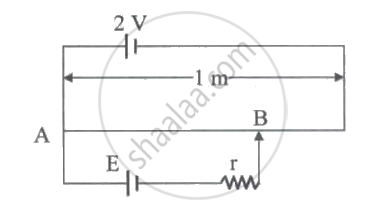
A potentiometer wire of length 100 cm and resistance 3 `Omega` is connected in series with resistance of 8 `Omega` and an accumulator of 4 volt whose internal resistance is 1 `Omega`.
A wire has a length of 2m and a resistance of 10Ω. It is connected in series with a resistance of 990Ω and a cell of e.m.f. 2V. The potential gradient along the wire will be ______
A student connected the circuit as shown in the figure to determine the internal resistance of a cell E1 by potentiometer (E > E1). He is unable to obtain the null point because ______.
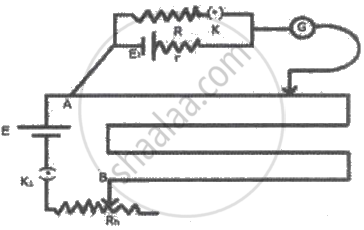
In a potentiometer experiment when three cells A, B, C are connected in series the balancing length is found to be 740 cm. If A and B are connected in series, the balancing length is 440 cm and when B and C are connected in series, it is 540 cm. The e.m.f. of A, B, and C cells EA, EB, EC are respectively (in volt) ______
In a potentiometer experiment, for measuring internal resistance of a cell, the balance point has been obtained on the fourth wire. The balance point can be shifted to fifth wire by ______.
AB is a wire of potentiometer with the increase in the value of resistance R, the shift in the balance point J will be ______.
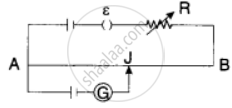
The best instrument for accurate measurement of EMF of a cell is ____________.
A 10 m long wire of uniform cross-section and 20 Ω resistance is used in a potentiometer. The wire is connected in series with a battery of 5 V along with an external resistance of 480 Ω. If an unknown emf E is balanced at 6.0 m length of the wire, then the value of unknown emf is ______.
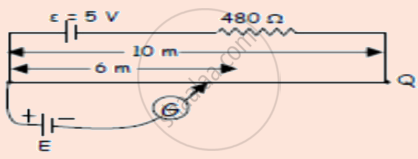
AB is a wire of potentiometer with the increase in value of resistance R, the shift in the balance point J will be:

The conductivity of super - conductor is
While doing an experiment with potentiometer (Figure) it was found that the deflection is one sided and (i) the deflection decreased while moving from one end A of the wire to the end B; (ii) the deflection increased. while the jockey was moved towards the end B.
- Which terminal + or – ve of the cell E1, is connected at X in case (i) and how is E1 related to E?
- Which terminal of the cell E1 is connected at X in case (ii)?
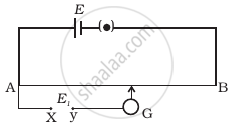
Potential difference between the points A and B in the circuit shown is 16 V, then potential difference across 2Ω resistor is ______ V. volt. (VA > VB)

A Daniel cell is balanced on 125 cm lengths of a potentiometer wire. Now the cell is short circuited by a resistance 2 Ω and the balance is obtained at 100 cm. The internal resistance of the Daniel cell is ______.
As a cell age, its internal resistance increases. A voltmeter of resistance 270 Ω connected across an old dry cell reads 1.44 V. However, a potentiometer at the balance point gives a voltage measurement of the cell as 1.5 V. Internal resistance of the cell is ______ Ω.
Two identical thin metal plates has charge q1 and q2 respectively such that q1 > q2. The plates were brought close to each other to form a parallel plate capacitor of capacitance C. The potential difference between them is ______.
A cell of internal resistance r is connected across an external resistance nr. Then the ratio of the terminal voltage to the emf of the cell is ______.
In potentiometer experiment, null point is obtained at a particular point for a cell on potentiometer wire x cm long. If the length of the potentiometer wire is increased without changing the cell, the balancing length will ______. (Driving source is not changed)
In balanced meter bridge, the resistance of bridge wire is 0.1 Ω cm. Unknown resistance X is connected in left gap and 6 Ω in right gap, null point divides the wire in the ratio 2:3. Find the current drawn from the battery of 5 V having negligible resistance.
Draw neat labelled diagram of potentiometer as voltage divider.
In a potentiometer, a cell is balanced against 110 cm when the circuit is open. A cell is balanced at 100 cm when short-circuited through a resistance of 10 Ω. Find the internal resistance of the cell.
